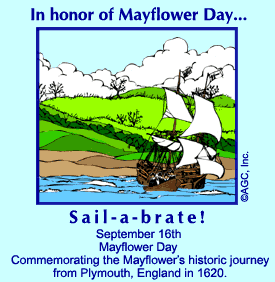The Mayflower sails from Plymouth, England, bound for the New World with 102 passengers. The ship was headed for Virginia, where the colonists - half religious dissenters and half entrepreneurs - had been authorized to settle by the British crown. However, stormy weather and navigational errors forced the Mayflower off course, and on November 21 the "Pilgrims" reached Massachusetts, where they founded the first permanent European settlement in New England in late December.
Thirty-five of the Pilgrims were members of the radical English Separatist Church, who traveled to America to escape the jurisdiction of the Church of England, which they found corrupt. Ten years earlier, English persecution had led a group of Separatists to flee to Holland in search of religious freedom. However, many were dissatisfied with economic opportunities in the Netherlands, and under the direction of William Bradford they decided to immigrate to Virginia, where an English colony had been founded at Jamestown in 1607.
The Separatists won financial backing from a group of investors called the London Adventurers, who were promised a sizable share of the colony's profits. Three dozen church members made their way back to England, where they were joined by about 70 entrepreneurs-enlisted by the London stock company to ensure the success of the enterprise. In August 1620, the Mayflower left Southampton with a smaller vessel--theSpeedwell-but the latter proved unseaworthy and twice was forced to return to port. On September 16, the Mayflower left for America alone from Plymouth.
In a difficult Atlantic crossing, the 90-foot Mayflower encountered rough seas and storms and was blown more than 500 miles off course. Along the way, the settlers formulated and signed the Mayflower Compact, an agreement that bound the signatories into a "civil body politic." Because it established constitutional law and the rule of the majority, the compact is regarded as an important precursor to American democracy. After a 66-day voyage, the ship landed on November 21 on the tip of Cape Cod at what is now Provincetown, Massachusetts.
After coming to anchor in Provincetown harbor, a party of armed men under the command of Captain Myles Standish was sent out to explore the area and find a location suitable for settlement. While they were gone, Susanna White gave birth to a son, Peregrine, aboard the Mayflower. He was the first English child born in New England. In mid-December, the explorers went ashore at a location across Cape Cod Bay where they found cleared fields and plentiful running water and named the site Plymouth.
The expedition returned to Provincetown, and on December 21 the Mayflower came to anchor in Plymouth harbor. Just after Christmas, the pilgrims began work on dwellings that would shelter them through their difficult first winter in America.
In the first year of settlement, half the colonists died of disease. In 1621, the health and economic condition of the colonists improved, and that autumn Governor William Bradford invited neighboring Indians to Plymouth to celebrate the bounty of that year's harvest season. Plymouth soon secured treaties with most local Indian tribes, and the economy steadily grew, and more colonists were attracted to the settlement. By the mid 1640s, Plymouth's population numbered 3,000 people, but by then the settlement had been overshadowed by the larger Massachusetts Bay Colony to the north, settled by Puritans in 1629.
The term "Pilgrim" was not used to describe the Plymouth colonists until the early 19th century and was derived from a manuscript in which Governor Bradford spoke of the "saints" who left Holland as "pilgrimes." The orator Daniel Webster spoke of "Pilgrim Fathers" at a bicentennial celebration of Plymouth's founding in 1820, and thereafter the term entered common usage.

Комментариев нет:
Отправить комментарий